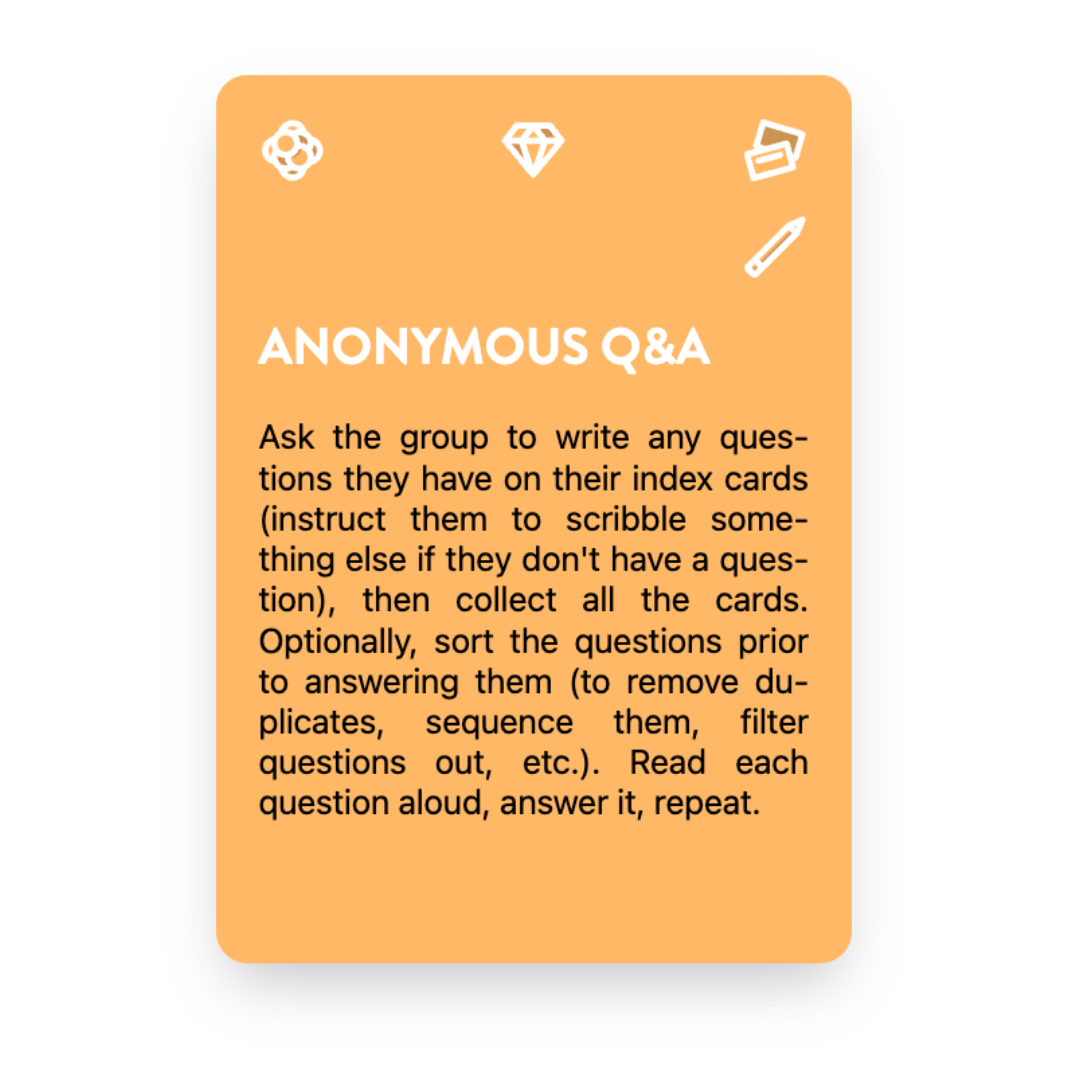Anonymous Q&A is a powerful clarifying process that we use in both virtual and in-person sessions. By collecting questions from participants anonymously we increase participation and get the questions people really want answers to.
When To Use
This framework is helpful in so many situations.
When you’re tackling a large topic and have limited time it’s a great way to get to the urgent questions that you want to make sure everyone gets an answer to.
It’s great for when your participants might be hesitant to say their questions aloud. Whether that’s because it’s a work meeting where admitting to not knowing something would be a vulnerable situation, they have a question that they aren’t sure how to word, or any situation where it would be uncomfortable. Getting honest questions leads to a better answer!
For panels where audience members are submitting questions, Anonymous Q&A allows the moderators to filter out “questions” that are more statements in disguise.
If you’re running a cohort or multi-day session, running an Anonymous Q&A can help you shape future session agendas based on what your participants are curious about.
In terms of where we place it on our agenda, we’re big fans of collecting questions right before a break! This gives you some time to filter through the questions and think through your responses without an audience.
When it comes to answering questions, we limit it to around 10-15 minutes. Even when the questions are interesting, participants’ attention starts to wane. Something we’ve done recently is filming our answers to some questions we weren’t able to answer during the session and sending the video in our follow-up!
How We Do It
The simplest way to do Anonymous Q&A is to pass out index cards to participants, have them write their answers (and to keep it truly anonymous, we request that everyone write something even if it’s “I don’t have a question”), and collect them. Pro tip: ask participants to flip the card over without folding it when they’re done writing. Save yourself some time—the seconds opening up the cards add up!
When we run Anonymous Q&A during virtual sessions we have a few options:
🧾 Have participants submit a Google Form
🛝 Gather questions on Google Slides
📊 Set up a question poll on AhaSlides* or Mentimeter
💨 Create a form on Airtable
*A bonus of gathering questions on software like AhaSlides is that other participants can upvote questions to give you a better idea of what your group is most curious about!
Powerful Facilitator Card Combinations
Anonymous Q&A + Frequently Asked Questions
Create a numbered list of questions from the ones you collect from participants! Frequently Asked Questions is a great way to filter the questions you want to answer and then turn the agency back over to your participants in terms of what they want answers to.
Minute Paper → Anonymous Q&A
Before submitting their questions, have participants write a quick minute paper to reflect on what questions they might have. Sometimes having some time to digest information allows them to be more specific with their questions.
Anonymous Q&A → Hot Seat
After reading out the question, ask if any participants want to come up to the Hot Seat to give their answer to that question and follow-ups the group may have.
Why We 💛 It
The power of anonymity is not to be underestimated. Whether your participants are students who might be embarrassed to ask questions in front of their friends, co-workers who don’t want to say the wrong thing in a professional development seminar, or participants who don’t want to speak in front of a large crowd, Anonymous Q&A has got their back!
There are so many situations where it becomes high risk to admit when we don’t know something. Anonymous Q&A is a process that provides simple psychological safety.
Want specific guidance for enhancing how you answer questions? Read Meg’s best tips & practices!
